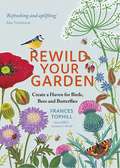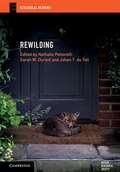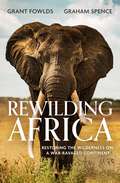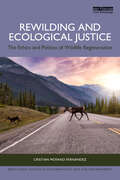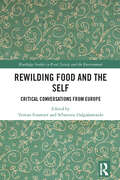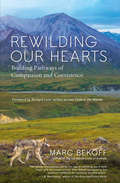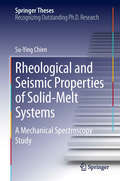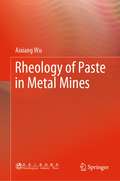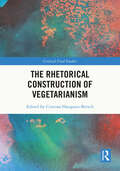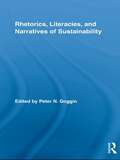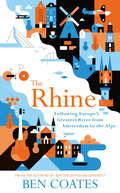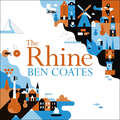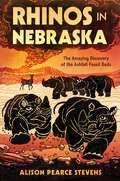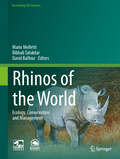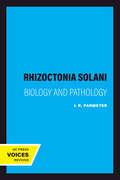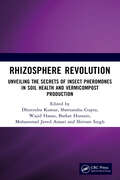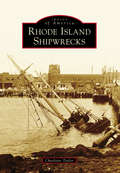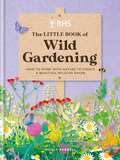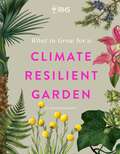- Table View
- List View
Rewild Your Garden: Create a Haven for Birds, Bees and Butterflies
by Frances Tophill'A refreshing, uplifting and positive look at the true value of a garden.' -- Alan TitchmarshThe perfect book for any gardener looking to get back in touch with their wild side.The rewilding of public spaces and farmland is vitally important to conservation, but how can we support native species and provide rich habitats on our own doorsteps?In this practical, beautifully illustrated guide horticulturalist and Gardener's World presenter Frances Tophill shows you how to plan and maintain a beautiful garden that will attract bees and birds as well as a throng of unsung garden heroes. Whether you have a small balcony or a large open space, discover the joys of welcoming natural ecosystems back into your garden - along with a host of new visitors.
Rewilding (Ecological Reviews)
by Nathalie Pettorelli Sarah M. Durant Johan T. du ToitThrough a global and interdisciplinary lens, this book discusses, analyzes and summarizes the novel conservation approach of rewilding. The volume introduces key rewilding definitions and initiatives, highlighting their similarities and differences. It reviews matches and mismatches between the current state of ecological knowledge and the stated aims of rewilding projects, and discusses the role of human action in rewilding initiatives. Collating current scholarship, the book also considers the merits and dangers of rewilding approaches, as well as the economic and socio-political realities of using rewilding as a conservation tool. Its interdisciplinary nature will appeal to a broad range of readers, from primary ecologists and conservation biologists to land managers, policy makers and conservation practitioners in NGOs and government departments. Written for a scientifically literate readership of academics, researchers, students, and managers, the book also acts as a key resource for advanced undergraduate and graduate courses.
Rewilding Africa: Restoring the Wilderness on a War-ravaged Continent
by Grant Fowlds Graham SpenceConservationist Grant Fowlds lives to save and protect Africa's rhinos, elephants and other iconic wildlife, to preserve their habitats, to increase their range and bring back the animals where they have been decimated by decades of war, as in Angola, Mozambique and the Democratic Republic of the Congo. This vivid account of his work tells of a fellow conservationist tragically killed by the elephants he was seeking to save and a face-off with poachers, impoverished rural people exploited by rapacious local businessmen. Fowlds describes the impact of the Covid pandemic on conservation efforts, the vital wildlife tourism that sustains these and rural communities; and tells of conservationists' efforts to support people through the crisis. Lockdowns may have brought a welcome lull in rhino and other poaching, but also brought precious tourism to a standstill. He shows how the pandemic has highlighted the danger to the world of the illicit trade in endangered wildlife, some of it sold in 'wet markets', where pathogens incubate and spread. He describes a restoration project of apartheid-era, ex-South African soldiers seeking to make reparations in Angola, engulfed for many years in a profoundly damaging civil war, which drew in outside forces, from Cuba, Russia and South Africa, with a catastophic impact on that country's wildlife. Those who fund conservation, whether in the US, Zambia or South Africa itself, are of vital importance to efforts to conserve and rewild: some supposed angel-investors turn out to be not what they had appeared, some are thwarted in their efforts, but others are open-hearted and generous in the extreme, which makes their sudden, unexpected death an even greater tragedy. A passionate desire to conserve nature has also brought conservationists previously active in far-off Venezuela to southern Africa. Fowlds describes fraught meetings to negotiate the coexistence of wildlife and rural communities. There are vivid accounts of the skilled and dangerous work of using helicopters to keep wildebeest, carrying disease, and cattle apart, and to keep elephants from damaging communal land and eating crops such as sugar cane. He tells of a project to restore Africa's previously vast herds of elephants, particularly the famed 'tuskers', with their unusually large tusks, once prized and hunted almost to extinction. The range expansion that this entails is key to enabling Africa's iconic wildlife to survive, to preserving its wilderness and, in turn, helping humankind to survive.There is a heartening look at conservation efforts in Mozambique, a country scarred by years of war, which are starting to bear fruit, though just as a new ISIS insurgency creates havoc in the north of the country. What will humanity's relationship with nature be post-pandemic? Will we have begun to learn that by conserving iconic wildlife and their habitats we help to preserve and restore precious pockets of wilderness, which are so vital not only the survival of wildlife, but to our own survival on our one precious planet.
Rewilding Africa: Restoring the Wilderness on a War-ravaged Continent
by Grant Fowlds Graham SpenceConservationist Grant Fowlds lives to save and protect Africa's rhinos, elephants and other iconic wildlife, to preserve their habitats, to increase their range and bring back the animals where they have been decimated by decades of war, as in Angola, Mozambique and the Democratic Republic of the Congo. This vivid account of his work tells of a fellow conservationist tragically killed by the elephants he was seeking to save and a face-off with poachers, impoverished rural people exploited by rapacious local businessmen. Fowlds describes the impact of the Covid pandemic on conservation efforts, the vital wildlife tourism that sustains these and rural communities; and tells of conservationists' efforts to support people through the crisis. Lockdowns may have brought a welcome lull in rhino and other poaching, but also brought precious tourism to a standstill. He shows how the pandemic has highlighted the danger to the world of the illicit trade in endangered wildlife, some of it sold in 'wet markets', where pathogens incubate and spread. He describes a restoration project of apartheid-era, ex-South African soldiers seeking to make reparations in Angola, engulfed for many years in a profoundly damaging civil war, which drew in outside forces, from Cuba, Russia and South Africa, with a catastophic impact on that country's wildlife. Those who fund conservation, whether in the US, Zambia or South Africa itself, are of vital importance to efforts to conserve and rewild: some supposed angel-investors turn out to be not what they had appeared, some are thwarted in their efforts, but others are open-hearted and generous in the extreme, which makes their sudden, unexpected death an even greater tragedy. A passionate desire to conserve nature has also brought conservationists previously active in far-off Venezuela to southern Africa. Fowlds describes fraught meetings to negotiate the coexistence of wildlife and rural communities. There are vivid accounts of the skilled and dangerous work of using helicopters to keep wildebeest, carrying disease, and cattle apart, and to keep elephants from damaging communal land and eating crops such as sugar cane. He tells of a project to restore Africa's previously vast herds of elephants, particularly the famed 'tuskers', with their unusually large tusks, once prized and hunted almost to extinction. The range expansion that this entails is key to enabling Africa's iconic wildlife to survive, to preserving its wilderness and, in turn, helping humankind to survive.There is a heartening look at conservation efforts in Mozambique, a country scarred by years of war, which are starting to bear fruit, though just as a new ISIS insurgency creates havoc in the north of the country. What will humanity's relationship with nature be post-pandemic? Will we have begun to learn that by conserving iconic wildlife and their habitats we help to preserve and restore precious pockets of wilderness, which are so vital not only the survival of wildlife, but to our own survival on our one precious planet.
Rewilding Agricultural Landscapes: A California Study in Rebalancing the Needs of People and Nature
by H. Scott ButterfieldAs the world population grows, so does the demand for food, putting unprecedented pressure on agricultural lands. In many desert dryland regions, however, intensive cultivation is causing their productivity to decline precipitously. "Rewilding&” the least productive of these landscapes offers a sensible way to reverse the damage, recover natural diversity, and ensure long-term sustainability of remaining farms and the communities they support. This accessibly written, groundbreaking contributed volume is the first to examine in detail what it would take to retire eligible farmland and restore functioning natural ecosystems. The lessons in Rewilding Agricultural Landscapes will be useful to conservation leaders, policymakers, groundwater agencies, and water mangers looking for inspiration and practical advice for solving the complicated issues of agricultural sustainability and water management.
Rewilding and Ecological Justice: The Ethics and Politics of Wildlife Regeneration (Routledge Studies in Conservation and the Environment)
by Cristian Moyano-FernándezThis book presents rewilding as a matter of ecological justice. To date, most books and articles on rewilding have viewed this concept through the lens of environmental science, while others have analyzed it from a political, ethical, and philosophical perspective. However, little attention has so far been paid to the justice angle of rewilding. Why and how should justice for rewilding be articulated? In order to address this question, Rewilding and Ecological Justice delves into the capabilities approach extended to nonhumans, distributive theories of ecological justice, welfare biology strategies applied to wildlife, environmental virtues, philosophies of recognition and identity, and decolonial studies. By discussing these narratives, this book is able to outline a roadmap indicating the key factors which should be considered in a justice approach to wildlife regeneration. Given the current and worsening socioecological crisis, rewilding initiatives are likely to increase, so this book explores how to ensure that their development is just for all, inclusive of both humans and nonhumans, drawing on examples from across the globe.This book will be of great interest to students and scholars of rewilding, ecological ethics and justice, environmental philosophy, biodiversity conservation, and ecological restoration.
Rewilding Food and the Self: Critical Conversations from Europe (Routledge Studies in Food, Society and the Environment)
by Tristan Fournier Sébastien DalgalarrondoThis volume contributes to the return to nature movement that is very much in vogue in contemporary European societies, by examining the place of food and eating in the "rewilding" process. It is divided into three parts, each of which consists of conversations between social scientists, with fieldwork collected from across Denmark, Finland, France, Italy, Norway and Switzerland. The first part focuses on the ways in which the hunter-gatherer livelihood has been transformed into a resilient, simpler and ecological way of life. It is dedicated to hunting and identifies the contexts in which large wild game meat is consumed and the reasons why such a product is still valued today. The second part shows how some practices that aim to reconnect with natural processes are developing within a market economy. Case studies on natural wine and fasting retreats help us to identify the promises that producers and promoters are relying on in order to disseminate them. Finally, the third part considers how this process of rewilding food is expressed in post-modernity. By focusing on two normative frameworks in which the rhetoric of the wild is mobilized although it is not expected to be in these terms – urbanity and the gender order – the goal is to understand the extent to which referring to the wild in food discourses and practices contributes to challenging our identities, and to creating possible forms of emancipation. This book will be of great interest to students and scholars interested in food cultures, human nature relationships, and sustainable diets.
Rewilding North America: A Vision For Conservation In The 21St Century
by Dave ForemanDave Foreman is one of North America's most creative and effective conservation leaders, an outspoken proponent of protecting and restoring the earth's wildness, and a visionary thinker. Over the past 30 years, he has helped set direction for some of our most influential conservation organizations, served as editor and publisher of key conservation journals, and shared with readers his unique style and outlook in widely acclaimed books including The Big Outside and Confessions of an Eco-Warrior.In Rewilding North America, Dave Foreman takes on arguably the biggest ecological threat of our time: the global extinction crisis. He not only explains the problem in clear and powerful terms, but also offers a bold, hopeful, scientifically credible, and practically achievable solution.Foreman begins by setting out the specific evidence that a mass extinction is happening and analyzes how humans are causing it. Adapting Aldo Leopold's idea of ecological wounds, he details human impacts on species survival in seven categories, including direct killing, habitat loss and fragmentation, exotic species, and climate change. Foreman describes recent discoveries in conservation biology that call for wildlands networks instead of isolated protected areas, and, reviewing the history of protected areas, shows how wildlands networks are a logical next step for the conservation movement. The final section describes specific approaches for designing such networks (based on the work of the Wildlands Project, an organization Foreman helped to found) and offers concrete and workable reforms for establishing them. The author closes with an inspiring and empowering call to action for scientists and activists alike.Rewilding North America offers both a vision and a strategy for reconnecting, restoring, and rewilding the North American continent, and is an essential guidebook for anyone concerned with the future of life on earth.
Rewilding Our Hearts: Building Pathways of Compassion and Coexistence
by Marc BekoffIn wildlife conservation, rewilding refers to restoring habitats and creating corridors between preserved lands to allow declining populations to rebound. Marc Bekoff, one of the world’s leading animal experts and activists, here applies rewilding to human attitudes. Rewilding Our Hearts invites readers to do the essential work of becoming reenchanted with the world, acting from the inside out, and dissolving false boundaries to truly connect with both nature and themselves.
Rheological and Seismic Properties of Solid-Melt Systems
by Su-Ying ChienOur understanding of the rheological and seismic properties of the Earth's interior relies on interpreting geophysical observations using mineral physics data. The complexity of natural materials complicates these interpretations, but here the key features of such materials in controlling the attenuation of seismic waves are determined by a set of careful experiments. This thesis clearly explains how dynamic mechanical spectroscopy has been used to determine the visco-elastic properties of igneous and sedimentary rocks containing geological fluids. These experiments highlight, for the first time, the importance of mineral and rock microstructures as controls on geophysical properties of solids, particularly near the melting point. The results have impacts in areas ranging from volcanic processes, through the structure of the deep Earth, to fluid-saturated porous media.
Rheology of Paste in Metal Mines
by Aixiang WuThis book investigates the rheology of paste in metal mines, which is beneficial for cemented paste backfill (CPB) technology. This book establishes a theory frame of paste rheology, including measurement of the rheological properties of paste, rheological behavior of full tailings in deep thickening, rheological behavior of paste in the mixing process, rheological behavior of paste in pipeline transportation, and rheological behavior of filling body. It aims to promote the development of paste theory, the innovation of CPB technology, and the research and development of CPB equipment to accelerate the construction of green mines based on CPB. This book is intended for researchers, designers, and engineering technicians. This book can also be a textbook for postgraduate students on mining engineering and other related subjects.
The Rhetorical Construction of Vegetarianism (Critical Food Studies)
by Cristina Hanganu-BreschThis book explores themes in the rhetoric of vegetarian discourse. A vegan practice may help mitigate crises such as climate change, global health challenges, and sharpening socioeconomic disparities, by ensuring both fairness in the treatment of animals and food justice for marginalized populations. How the message is spread is crucial for these aims. Vegan practices thus uncover tensions between individual dietary choices and social justice activism, between ego and eco, between human and animal, between capitalism and environmentalism, and within the larger universe of theoretical and practical ethics. The chapters apply rhetorical methodologies to understand vegan/vegetarian discourse, emphasizing, for example, vegan/vegetarian rhetoric through the lens of polyphony, the role of intersectional rhetoric in becoming vegan, as well as ecofeminist, semiotic, and discourse theory approaches to veganism. The book aims to show that a rhetorical understanding of vegetarian and vegan discourse is crucial for the goals of movements promoting veganism. The book is intended for a wide interdisciplinary audience of scholars, researchers, and individuals interested in veganism, food and media studies, rhetorical studies, human-animal studies, cultural studies and related disciplines. It urges readers to examine vegan discourses seriously, not just as a matter of personal choice or taste but as one vital for intersectional justice and our planetary survival.
Rhetorics, Literacies, and Narratives of Sustainability (Routledge Studies in Rhetoric and Communication)
by Peter N. GogginIn this volume, rhetoricians, literacy scholars, and humanists have come together to examine the complex discursive constructions of sustainability. Touching on topics including conservation efforts in specific locales; social and political constructions of rhetorical place and space; community literacy; historical and archival analysis of institutional politics, policies, and practices concerning the environment and economic growth and development; town planning and zoning issues; and rhetorics of environmental remediation and sustainability, this collection of essays provides rhetoricians and environmentalists a window into the complex and often contradictory arena of discourse on sustainability.
The Rhine: Following Europe’s Greatest River from Amsterdam to the Alps
by Ben CoatesThe Rhine is one of the world's greatest rivers. Once forming the outer frontier of the Roman Empire, it flows 800 miles from the social democratic playground of the Netherlands, through the industrial and political powerhouses of Germany and France, to the wealthy mountain fortresses of Switzerland and Liechtenstein. For five years, Ben Coates lived alongside a major channel of the river in Rotterdam, crossing it daily, swimming and sailing in its tributaries. In The Rhine, he sets out by bicycle from the Netherlands where it enters the North Sea, following it through Germany, France and Liechtenstein, to its source in the icy Alps. He explores the impact that the Rhine has had on European culture and history and finds out how influences have flowed along and across the river, shaping the people who live alongside it. Blending travelogue and offbeat history, The Rhine tells the fascinating story of how a great river helped shape a continent.
The Rhine: Following Europe's Greatest River from Amsterdam to the Alps
by Ben Coates*SHORTLISTED FOR THE STANFORD DOLMAN TRAVEL BOOK OF THE YEAR AWARD*Ben Coates, author of Why the Dutch are Different, cycles the Rhine river from mouth to source, discovering the mark it makes on Europe.The Rhine is one of the world's greatest rivers. Once forming the outer frontier of the Roman Empire, it flows 800 miles from the social democratic playground of the Netherlands, through the industrial and political powerhouses of Germany and France, to the wealthy mountain fortresses of Switzerland and Liechtenstein. For five years, Ben Coates lived alongside a major channel of the river in Rotterdam, crossing it daily, swimming and sailing in its tributaries. In The Rhine, he sets out by bicycle from the Netherlands where it enters the North Sea, following it through Germany, France and Liechtenstein, to its source in the icy Alps. He explores the impact that the Rhine has had on European culture and history and finds out how influences have flowed along and across the river, shaping the people who live alongside it. Blending travelogue and offbeat history, The Rhine tells the fascinating story of how a great river helped shape a continent.(P) 2021 Hodder & Stoughton Limited
Rhinos in Nebraska: The Amazing Discovery of the Ashfall Fossil Beds
by Alison Pearce StevensTwelve million years ago, rhinos, elephants, and camels roamed North America. They would gather at nearby watering holes—eating, drinking, and trying not to become someone else’s lunch. But one day, in what we now know as Nebraska, everything changed. The explosion of a supervolcano a thousand miles away sent a blanket of ash that buried these animals for millennia.Until 1953, when a seventeen-year-old farm worker made an unbelievable discovery.Rhinos in Nebraska tells the story of the Ashfall Fossil Beds, where more than two hundred perfectly preserved fossils have been found. Step into the past with author Alison Pearce Stevens and uncover the mysteries of Ashfall.
Rhinos of the World: Ecology, Conservation and Management (Fascinating Life Sciences)
by Mario Melletti Bibhab Talukdar David BalfourThis book represents the culmination of more than four years of work by many rhino experts, primarily from Africa, Asia, the United States, and Europe, involved in rhino conservation, research and management. It is one of the most comprehensive reference works ever published on the systematics, ecology, conservation status, and management of all rhinoceros species. Covering all five rhino species worldwide, this volume brings together the contributions of 92 international rhino experts and provides: A comprehensive overview of the current state of knowledge on the evolution, phylogeny, systematics, and fossil record of rhinos An in-depth look at the ecology and conservation status of each species, with detailed chapters A series of case studies on conservation management, poaching, horn trade, and ex-situ programs. This beautifully illustrated book is an invaluable resource for researchers, wildlife managers and professionals in conservation biology, ecology, and management, as well as the general public. It reveals the fascinating story of rhino evolution, the long history of human interactions with rhinos, and the major threats to these iconic species.
Rhizoctonia Solani: Biology and Pathology
by John R. ParmeterThis title is part of UC Press's Voices Revived program, which commemorates University of California Press’s mission to seek out and cultivate the brightest minds and give them voice, reach, and impact. Drawing on a backlist dating to 1893, Voices Revived makes high-quality, peer-reviewed scholarship accessible once again using print-on-demand technology. This title was originally published in 1970.This title is part of UC Press's Voices Revived program, which commemorates University of California Press’s mission to seek out and cultivate the brightest minds and give them voice, reach, and impact. Drawing on a backlist dating to 1893, Voices Revived</DIV
Rhizosphere Revolution: Unveiling the Secrets of Insect Pheromones in Soil Health and Vermicompost Production
by Dhirendra Kumar Sheetanshu Gupta Wajid Hasan Barkat Hussain Mohammad Javed Ansari Shivom SinghThis book analyses the complexities of the rhizosphere ecosystem and discusses the role of insect pheromones in shaping soil health and vermicompost production. It details the mechanisms of insect pheromone communication, their impact on soil microbial communities, and their potential applications in sustainable agriculture and vermicompost production.The subject matter in this book also discusses: The Underground Symphony Pheromones in Pest Control The Sentient Soil Hypothesis Bio-Engineered Insect Allies The Global Impact of Rhizosphere Revolution Print edition not for sale in South Asia (India, Sri Lanka, Nepal, Bangladesh, Pakistan or Bhutan)
Rhode Island Shipwrecks (Images of America)
by Charlotte TaylorRhode Island, the Ocean State, has more shipwrecks per square mile than any other state. The south coast and Block Island are the resting places of many shipwrecks, with many more located in Narragansett Bay. The record of shipwrecks in Rhode Island begins immediately after the arrival of Europeans in the early 17th century with the grounding of a Dutch trading vessel, and thousands more vessels came to grief in its waters in the following centuries, through bad weather, human error, equipment failure, and military action. Some of these shipwrecks were epic disasters, with many fatalities and the total loss of the vessel; others were relatively minor misfortunes in which the ships were salvageable. Many shipwrecks from the 19th century on into the 20th were captured in the dramatic images gathered here. These pictures show the variety of vessels that travelled Rhode Island�s waters back when the ocean was the primary transportation corridor and the many ways in which they met misfortune.
RHS Do Bees Need Weeds: A Gardener's Collection of Handy Hints for Greener Gardening
by Holly Farrell Gareth RichardsRHS Do Bees Need Weeds is packed with more than 100 practical questions and answers to help you become a more eco-friendly gardener, and show you how to adopt a more sustainable way of gardening. The book includes simple, low-cost ideas, from fun projects such as how to build a wormery or a homemade water butt to advice on which plants suit bees best and how to achieve a zero-waste garden.In these pages you will find dozens of solutions to common garden problems as well as inspiring innovations that reduce your gardening consumption, tackle waste and help the environment. Filled with fascinating facts and ideas that will help you make a real difference to the green credentials of your garden, this book is both informative and entertaining, with plenty of I-never-knew-that mini-features. This is a book you and your family need, and one that you'll all enjoy, too.Includes questions such as:- Which features will make my garden greener?- Are my garden lights harmful?- How can a lawn be wildlife-friendly?- Is it ever OK to have a bonfire?- Are there alternatives to plastic?- Can I grow year-round crops?- Is it OK to buy compost?
RHS The Little Book of Wild Gardening: How to work with nature to create a beautiful wildlife haven
by Holly FarrellThe Little Book of Wild Gardening is a guide for anyone wanting to garden in a more sustainable, natural way. Working with nature benefits not just the garden, but also the gardener, wildlife and the wider environment. Divided into sections for different garden areas - including lawns, flower beds, edibles, trees and water features - The Little Book of Wild Gardening details how to embrace a natural approach to gardening for plots large and small.Introductory chapters explain how garden ecosystems can work, and how a healthy garden can mean savings in both work and resources for the gardener. There are plant profiles providing a variety of choices for a wilder approach, plus design tips and expertise in sustainable and wildlife-friendly gardening. From a sustainable veg patch to wildflower meadows, and from bat boxes to gravel gardens, the book includes projects and plants in a range of sizes and timescales so gardeners can create a bountiful and enjoyable haven that will benefit themselves, their local area, and all kinds of wildlife.
RHS The Little Book of Wild Gardening: How to work with nature to create a beautiful wildlife haven
by Holly FarrellThe Little Book of Wild Gardening is a guide for anyone wanting to garden in a more sustainable, natural way. Working with nature benefits not just the garden, but also the gardener, wildlife and the wider environment. Divided into sections for different garden areas - including lawns, flower beds, edibles, trees and water features - The Little Book of Wild Gardening details how to embrace a natural approach to gardening for plots large and small.Introductory chapters explain how garden ecosystems can work, and how a healthy garden can mean savings in both work and resources for the gardener. There are plant profiles providing a variety of choices for a wilder approach, plus design tips and expertise in sustainable and wildlife-friendly gardening. From a sustainable veg patch to wildflower meadows, and from bat boxes to gravel gardens, the book includes projects and plants in a range of sizes and timescales so gardeners can create a bountiful and enjoyable haven that will benefit themselves, their local area, and all kinds of wildlife.
RHS What to Grow for a Climate Resilient Garden: Practical advice for gardeners on plants that can cope in all climates
by Dr Amanda Rasmussen Royal Horticultural SocietyAs the world's climate changes, this timely book from plant expert, Dr Amanda Rasmussen, explains what we should be planting in our outdoor spaces.What to Grow for a Climate Resilient Garden urges green-thumbed readers that are conscious of the environment to think deeper about the impact of maintaining a thriving garden on the future of the planet, and vice versa. With easy, practical ideas, it is the ideal book for experienced gardeners and a growing environmentally-inclined public looking for ways to make a difference.Eminent plant expert Dr Amanda Rasmussen explains what makes particular plants suited to certain conditions, along with easy-to-implement ideas for forward-thinking gardeners. Whether you are gardening in the rain, the baking hot sun, in the city or the countryside, you'll discover information and inspiration for creating your very own resilient garden.The author's expertise ensures a book that is botanically sound, but also aesthetically designed and eye-catching. The fascinating information about easy-to-find plants for a wide range of abilities and geographically diverse locations makes this book highly desirable for all gardeners wishing to diversify their green spaces as the climate continues to change radically.
RHS What to Grow for a Climate Resilient Garden: Practical advice for gardeners on plants that can cope in all climates
by Dr Amanda Rasmussen Royal Horticultural SocietyAs the world's climate changes, this timely book from plant expert, Dr Amanda Rasmussen, explains what we should be planting in our outdoor spaces.What to Grow for a Climate Resilient Garden urges green-thumbed readers that are conscious of the environment to think deeper about the impact of maintaining a thriving garden on the future of the planet, and vice versa. With easy, practical ideas, it is the ideal book for experienced gardeners and a growing environmentally-inclined public looking for ways to make a difference.Eminent plant expert Dr Amanda Rasmussen explains what makes particular plants suited to certain conditions, along with easy-to-implement ideas for forward-thinking gardeners. Whether you are gardening in the rain, the baking hot sun, in the city or the countryside, you'll discover information and inspiration for creating your very own resilient garden.The author's expertise ensures a book that is botanically sound, but also aesthetically designed and eye-catching. The fascinating information about easy-to-find plants for a wide range of abilities and geographically diverse locations makes this book highly desirable for all gardeners wishing to diversify their green spaces as the climate continues to change radically.
